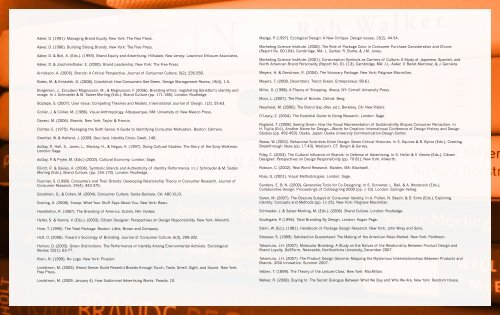The Effect of Packaging Design for Eco-Conscious ... - Tate Ragland
The Effect of Packaging Design for Eco-Conscious ... - Tate Ragland
The Effect of Packaging Design for Eco-Conscious ... - Tate Ragland
- No tags were found...
You also want an ePaper? Increase the reach of your titles
YUMPU automatically turns print PDFs into web optimized ePapers that Google loves.
Aaker, D. (1991). Managing Brand Equity. New York: <strong>The</strong> Free Press.<br />
Aaker, D. (1996). Building Strong Brands. New York: <strong>The</strong> Free Press.<br />
Aaker, D. & Biel, A. (Eds.). (1993). Brand Equity and Advertising. Hillsdale, New Jersey: Lawrence Erlbaum Associates.<br />
Aaker, D. & Joachimsthaler, E. (2000). Brand Leadership. New York: <strong>The</strong> Free Press.<br />
Arvidsson, A. (2005). Brands: A Critical Perspective. Journal <strong>of</strong> Consumer Culture, 5(2), 235-258.<br />
Bates, M. & Krist<strong>of</strong>ek, G. (2008). Colorblind: How Consumers See Green. <strong>Design</strong> Management Review, 19(4), 1-5.<br />
Borgerson, J., Escudero Magnusson, M., & Magnusson, F. (2006). Branding ethics: negotiating Benetton’s identity and<br />
image. In J. Schroeder & M. Salzer-Morling (Eds.), Brand Culture (pp. 171-185). London: Routledge.<br />
Boztepe, S. (2007). User Value: Competing <strong>The</strong>ories and Models. International Journal <strong>of</strong> <strong>Design</strong>, 1(2), 55-63.<br />
Collier, J. & Collier, M. (1986). Visual Anthropology. Albuquerque, NM: University <strong>of</strong> New Mexico Press.<br />
Danesi, M. (2006). Brands. New York: Taylor & Francis.<br />
Dichter, E. (1975). <strong>Packaging</strong> the Sixth Sense: A Guide to Identifying Consumer Motivation. Boston: Cahners.<br />
Drenttel, W. & Helfand, J. (2009, Dec/Jan). Identity Crisis. Dwell, 146.<br />
duGay, P., Hall, S., Janes, L., Mackay, H., & Negus, K. (1997). Doing Cultural Studies: <strong>The</strong> Story <strong>of</strong> the Sony Walkman.<br />
London: Sage.<br />
duGay, P. & Pryke, M. (Eds.) (2002). Cultural <strong>Eco</strong>nomy. London: Sage.<br />
Elliott, R. & Davies, A. (2006). Symbolic Brands and Authenticity <strong>of</strong> Identity Per<strong>for</strong>mance. In J. Schroeder & M. Salzer-<br />
Morling (Eds.), Brand Culture, (pp. 155-170). London: Routledge.<br />
Fournier, S. (1998). Consumers and <strong>The</strong>ir Brands: Developing Relationship <strong>The</strong>ory in Consumer Research. Journal <strong>of</strong><br />
Consumer Research, 24(4), 343-370.<br />
Goodman, D., & Cohen, M. (2004). Consumer Culture. Santa Barbara, CA: ABC-CLIO.<br />
Gosling, S. (2008). Snoop: What Your Stuff Says About You. New York: Basic.<br />
Hambleton, R. (1987). <strong>The</strong> Branding <strong>of</strong> America. Dublin, NH: Yankee.<br />
Heller, S. & Vienne, V. (Eds.). (2003). Citizen <strong>Design</strong>er: Perspectives on <strong>Design</strong> Responsibility. New York: Allworth.<br />
Hine, T. (1995). <strong>The</strong> Total Package. Boston: Little, Brown and Company.<br />
Holt, D. (2006). Toward a Sociology <strong>of</strong> Branding. Journal <strong>of</strong> Consumer Culture, 6(3), 299-302.<br />
Horton, D. (2003). Green Distinctions: <strong>The</strong> Per<strong>for</strong>mance <strong>of</strong> Identity Among Environmental Activists. Sociological<br />
Review, 52(1), 63-77.<br />
Klein, N. (1999). No Logo. New York: Picador.<br />
Lindstrom, M. (2005). Brand Sense: Build Powerful Brands through Touch, Taste, Smell, Sight, and Sound. New York:<br />
Free Press.<br />
Lindstrom, M. (2009, January 4). How Subliminal Advertising Works. Parade, 10.<br />
Madge, P. (1997). <strong>Eco</strong>logical <strong>Design</strong>: A New Critique. <strong>Design</strong> Issues, 13(2), 44-54.<br />
Marketing Science Institute. (2000). <strong>The</strong> Role <strong>of</strong> Package Color in Consumer Purchase Consideration and Choice<br />
(Report No. 00-104). Cambridge, MA: L. Garber, R. Burke, & J.M. Jones.<br />
Marketing Science Institute. (2001). Consumption Symbols as Carriers <strong>of</strong> Culture: A Study <strong>of</strong> Japanese, Spanish, and<br />
North American Brand Personality (Report No. 01-113). Cambridge, MA: J.L. Aaker, V. Benet-Martinez, & J. Garolera.<br />
Meyers, H. & Gerstman, R. (2004). <strong>The</strong> Visionary Package. New York: Palgrave Macmillan.<br />
Meyers, T. (2008, December). Trend: Green. Entrepreneur, 58-61.<br />
Miller, D. (1998). A <strong>The</strong>ory <strong>of</strong> Shopping. Ithaca, NY: Cornell University Press.<br />
Moor, L. (2007). <strong>The</strong> Rise <strong>of</strong> Brands. Ox<strong>for</strong>d: Berg.<br />
Neumeier, M. (2006). <strong>The</strong> Brand Gap (Rev. ed.). Berkeley, CA: New Riders.<br />
O’Leary, Z. (2004). <strong>The</strong> Essential Guide to Doing Research. London: Sage.<br />
<strong>Ragland</strong>, T. (2008). Seeing Green: How the Visual Representation <strong>of</strong> Sustainability Shapes Consumer Perception. In<br />
H. Fujita (Ed.), Another Name <strong>for</strong> <strong>Design</strong>—Words <strong>for</strong> Creation: International Conference <strong>of</strong> <strong>Design</strong> History and <strong>Design</strong><br />
Studies (pp. 456-459). Osaka, Japan: Osaka University Communication-<strong>Design</strong> Center.<br />
Reese, W. (2002). Behavioral Scientists Enter <strong>Design</strong>: Seven Critical Histories. In S. Squires & B. Byrne (Eds.), Creating<br />
Breakthrough Ideas (pp. 17-43). Westport, CT: Bergin & Garvey.<br />
Riley, C. (2003). <strong>The</strong> Cultural Influence <strong>of</strong> Brands: In Defense <strong>of</strong> Advertising. In S. Heller & V. Vienne (Eds.), Citizen<br />
<strong>Design</strong>er: Perspectives on <strong>Design</strong> Responsibility (pp. 70-81). New York: Allworth.<br />
Robson, C. (2002). Real World Research. Malden, MA: Blackwell.<br />
Rose, G. (2001). Visual Methodologies. London: Sage.<br />
Sanders, E. B.-N. (2000). Generative Tools <strong>for</strong> Co-<strong>Design</strong>ing. In S. Scrivener, L. Ball, & A. Woodcock (Eds.),<br />
Collaborative <strong>Design</strong>: Proceedings <strong>of</strong> Co<strong>Design</strong>ing 2000 (pp. 1-10). London: Springer-Verlag.<br />
Saren, M. (2007). <strong>The</strong> Obscure Subject <strong>of</strong> Consumer Identity. In A. Pullen, N. Beech, & D. Sims (Eds.), Exploring<br />
Identity: Concepts and Methods (pp. 11-25). New York: Palgrave Macmillan.<br />
Schroeder, J. & Salzer-Morling, M. (Eds.). (2006). Brand Culture. London: Routledge.<br />
Southgate, P. (1994). Total Branding By <strong>Design</strong>. London: Kogan Page.<br />
Stern, W. (Ed.). (1981). Handbook <strong>of</strong> Package <strong>Design</strong> Research. New York: John Wiley and Sons.<br />
Strasser, S. (1989). Satisfaction Guaranteed: <strong>The</strong> Making <strong>of</strong> the American Mass Market. New York: Pantheon.<br />
Takamura, J.H. (2007). Molecular Branding: A Study on the Nature <strong>of</strong> the Relationship Between Product <strong>Design</strong> and<br />
Brand Loyalty. DeSForm, Newcastle, Northumbria University, December 2007.<br />
Takamura, J.H. (2007). <strong>The</strong> Product <strong>Design</strong> Genome: Mapping the Mysterious Interrelationships Between Products and<br />
Brands. IDSA Innovation, Summer 2007.<br />
Veblen, T. (1899). <strong>The</strong> <strong>The</strong>ory <strong>of</strong> the Leisure Class. New York: MacMillan.<br />
Walker, R. (2008). Buying In: <strong>The</strong> Secret Dialogue Between What We Buy and Who We Are. New York: Random House.


